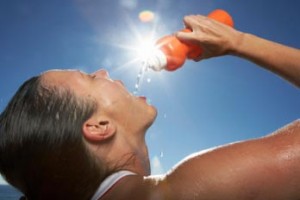Feelin hot hot hot!
Summer is fast approaching (few days to be exact!) and that usually means people freaking out as they put on their summer clothes only to find they don’t quite fit the way they used to. Summer is the perfect time to get outside and give your training a kick start, however the heat and humidity can really affect your body.
I want you to think about your body like a car, your car can overheat and so can we!
So if you are training outside, be smart and don’t let pride get in the way. There is no prize for pushing your body in very hot and humid conditions. Keep training by all means but I advise that in these conditions you make some adjustments to your usual regime so you can enjoy the health benefits and not be affected.
Hydration
To ensure you stay hydrated, you need to listen to your body. The standard “8 glasses a day” unfortunately just doesn’t cut it, 8 glasses isn’t much to someone who has done a lot of exercise. Water is needed to keep all your systems functioning properly, the water needed for a petite person is quite different to that of a larger person. Generally, hydration is considered to be when your urine is clear and you have a full bladder every two to three hours. To make sure you are well hydrated the best time to drink fluids is actually the day before you plan to exercise, this ensures you are hydrated for when you start. When you are exercising generally you want to drink 250mls per 15 minutes above 60 minutes of medium to high intensity training. Post exercise is again, an important time to hydrate if you are exercising for over 60 minutes you should consider having an electrolyte drink. ALWAYS make sure you have water available to you during training, it can sometimes get in the way but a waterbottle is a necessity for training in the heat.
(I advise using an electrolyte drink such as powerade or gatorade after completing intense exercise or endurance i.e marathon, where it is essential to get your hydration levels up. See my article on too much water to explain why you need to get your electrolytes in balance first. If you are just going for a walk you do not need one, water is sufficient)
Timing – beat the heat
When training in summer try training in the cooler times of the day – i.e morning or afternoon/evening. If you do like to get out and run or exercise during your lunch break, why not switch your exercise for low intensity or cooler options such as swimming, yoga or indoor strength training, even finding a shady spot in the park. Be sensible and plan ahead.
Intensity – don’t let your car overheat
If you choose to exercise during the heat, make sure you have an action plan in place that will make sure you don’t over do it. If you feel yourself over heating – drop your intensity down a bit to allow yourself to cool down. For example, increase your rest periods during interval training, pick flat courses if you are cycling or running and forget the hills.
Protect yourself – slip slop slap
Purchase some light coloured, breathable, loose fitting exercise gear this will allow your moisture to pass through and be evaporated – which keeps you cooler! Always, wear a hat, sunglasses that protect against UVA and UVB and ALWAYS wear waterproof sunscreen (I keep a bottle in my car for any client whose forgotten!). If you are a cyclist ensure your helmet allows airflow through it to cool the scalp.
Always choose the shady, softer cooler setting
Try to find naturally cooler surfaces to exercise on. Grass, sand, even white concrete footpaths are better than the road. In a park always try to exercise in the shade if possible, you can complete a pretty challenging circuit using not much space at all – think outside the box!)
Forget unrealistic expectations
Training in a cool or climate controlled environment is nothing like training in hot humid conditions. So as a result your performance may suffer. Don’t let this upset you, it’s normal. Trust me, my last fun run was in hot humid conditions, all I cared about was getting to the nearsest water station and saturating myself in O2. My time sucked, I felt slower than ever, but as slowly made my way through I felt better than the people lying on the street vomiting or being carried away from heat exhaustion – it’s just not worth it! If you push yourself to reach previous results you are at risk of overheating. Overheating can result in nausea/vomiting, dizziness, fainting, headaches, heatstrokes etc.
Most importantly, listen to your body – if you start to get muscle cramps, headaches, nausea STOP training find shade and start to drink some fluids. If you are exercising under someone elses instructions (i.e PT or group instructor) make sure you put your health first, you don’t need to impress. Professionaly as a PT I care about the welfare of my clients, it’s not about being soft it’s about looking after the health of people who have laid their trust in me.
Be smart and stay cool.
If you know someone who trains outdoors why not give them a friendly reminder by sharing this article using the buttons below!
